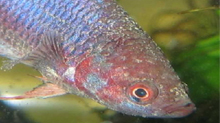Fungal diseases

Fungal diseases
Fungi are small, strand-like parasites. They normally do not infect healthy fish. They usually grow on dead tissue or infected wounds. Most of the fungi on fish have a patchy, gray-white, cotton-like appearance.
Saprolegniasis: Caused by various groups of aquatic fungi; primarily Saprolegnia, Achlya, and Aphanomyces.
Saprolegniasis affects all species and ages of freshwater and estuarine fish.

Clinically, affected fish develop white to brown cotton like growths on skin, fins, gills and dead eggs. This organism is an opportunist that will usually grow over previous ulcers or lesions. Diagnosis is by finding broad nonseptate branching hyphae that produce motile flagellated zoospores in the terminal sporangia. Most fish die due to osmotic or respiratory problems if the affected area of skin or gills is large. The fungi are normal water inhabitants that invade the traumatized epidermis. Improper handling, bacterial or viral skin diseases and trauma are the major causes of the disease. It is interesting to note that temperature has a significant effect on the development of infections. Most epizootics occur when temperatures are below the optimal temperature range for that species of fish.
Branchiomycosis (Gill rot): Caused by two species Branchiomyces sanguinis and B. demigrans. Primarily a problem in carp, rainbow and brown trout, and eels. Affected fish usually show respiratory distress. There is prominent gill necrosis caused by thrombosis of blood vessels in the gills. Histologically, the identification of nonseptate branching hyphae with an intrahyphal eosinophilic round body (apleospores) in and around blood vessels of the gill is diagnostic. The disease occurs most commonly in overcrowded ponds with abundant organic matter and high ammonia levels. Usually warm water temperatures (20-25°C) bring about the disease.
Ichthyosporidiosis: Ichthyophonus hoferi: large 10 250 micron spores which may germinate to form large hyphae (similar to the hyphae of Saprolegnia). This fungus infects all species of fish. Clinically the fish are emaciated with small round occasionally ulcerated black granulomas in the skin. Scoliosis is occasionally observed. Internally, numerous granulomas are observed in many visceral organs. Microscopically, the lesion consists of granulomas with encysted large PAS positive spores. Occasionally large irregular shaped hyphae are observed. Transmission is unknown, but believed to be due to ingestion of contaminated feed.
Suggested Products
- Address
- Neospark Drugs and Chemicals Private Limited Corporate Center,
241, B.L. Bagh, Panjagutta,
Hyderabad- 500 082,
Telangana, India.
- Product Groups
- Poultry
- Large Animal
- Aquaculture
- Feed
© 2025 Neospark Drugs and Chemicals Private Limited